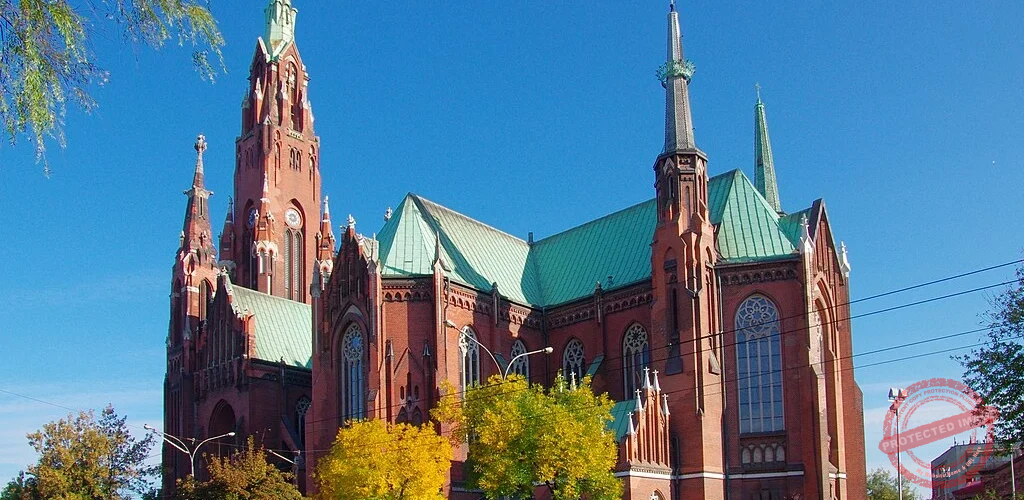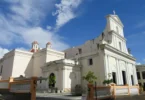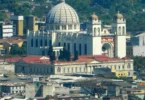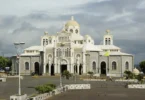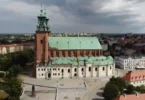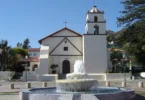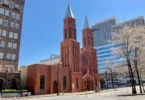Introduction
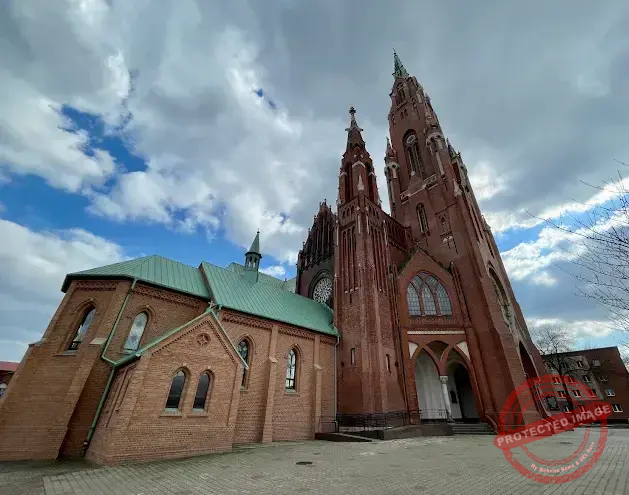
The Basilica of Our Lady of the Angels in Dąbrowa Górnicza is one of the most important spiritual places in the Sosnowiec diocese. It’s often called the Sanctuary of Our Lady of the Angels and the Mother of Zagłębie. At the center of the devotion here is a cedar wood statue of Our Lady of the Angels, carved in 1904 by Józef Baltazar Proszowski. This figure is known for its graces, and many people believe they’ve received blessings through her intercession. Since the late 1800s, the devotion to Mary as the Queen of Angels has been growing in the Dąbrowa Basin.The parish itself was officially founded in 1891 by Bishop Tomasz Kuliński from Kielce. A few years later, in 1897, the painting of the Queen of Angels was brought into the church with great ceremony. From the beginning, the faithful have shown deep reverence, and countless votive offerings have been left as thanks for answered prayers. This basilica also holds a special place in Polish church history. On March 19, 1901, Pope Leo XIII gave it the honorary title of a pro-basilica the first sanctuary in Poland to receive such recognition from the Holy See. The current church building was constructed between 1898 and 1912, designed in a neo-Gothic style known as Vistula Gothic by architect Józef Stefan Pomian-Pomianowski. It was built alongside the older St. Alexander’s Church, which dated back to 1875–1877. The person behind the project was Father Grzegorz Augustynik. The church was finally consecrated on September 29, 1912, by Bishop Augustyn Łosiński of Kielce.
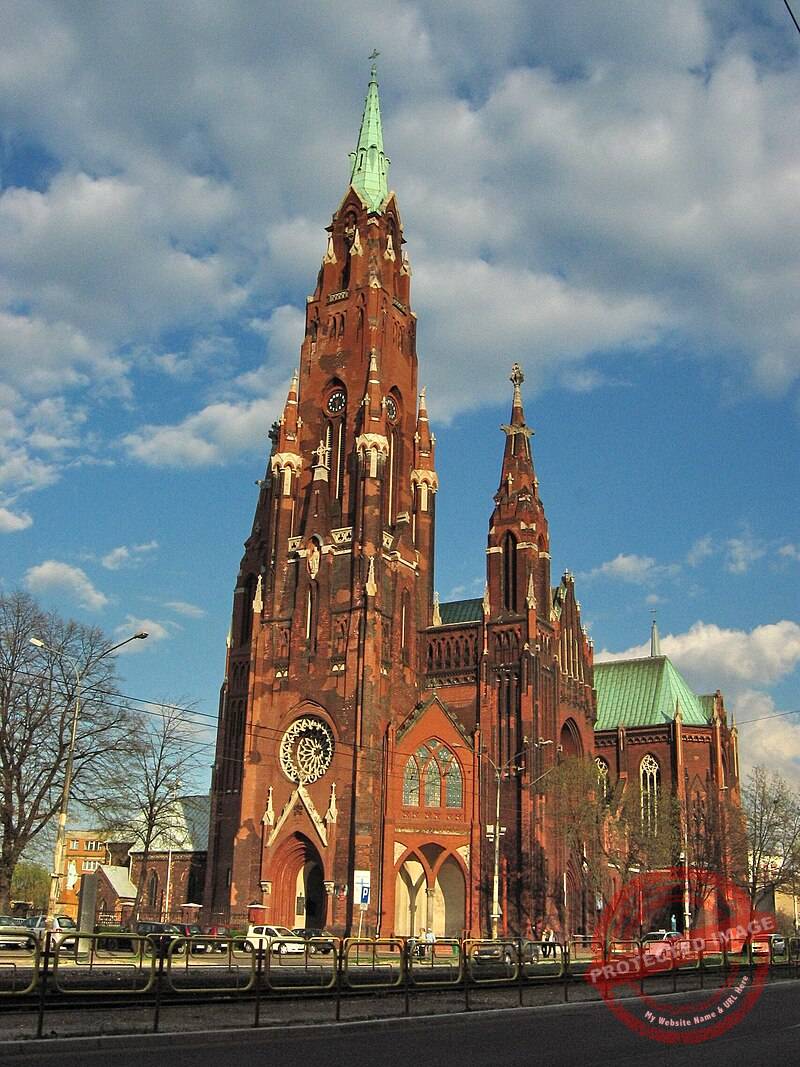
The first church
The first church in the village of Stara Dąbrowa, dedicated to St. Alexander, was built between 1875 and 1877. On July 29, 1875, the cornerstone was laid for the church, whose main builder was Father Grzegorz Augustynik . The brick, single-nave structure with two towers in the front was built based on designs by Julian Polcer. Construction was completed on December 4, 1877. It was a branch church of the Holy Trinity parish in Będzin. On October 18, 1885, it was consecrated by the Bishop of Kielce, Tomasz Teofil Kuliński . This church adjoins the northern nave of the present basilica and serves as a chapel dedicated to St. Alexander.
Expansion of the temple
After St. Alexander’s Church was built, it proved too small. The then-caretaker of the church, Father Dutkiewicz, began applying for permission to build a second church in the upper part of Dąbrowa. The authorities submitted a proposal for approval, conditional on the conversion of the existing church into an Orthodox church. Father Dutkiewicz refused this condition, and due to his public criticism, he was forced to flee Dąbrowa to escape the authorities. He reached America, from where he sent funds for the construction of a new church. Eventually, the expansion of St. Alexander’s Church was undertaken, and the authorities agreed. The two towers at the front of the church were demolished, and a new church was practically built, connected to the old one, which was transformed into a spacious chapel. All the workers in Dąbrowa contributed to the financing of the construction, as their workplaces had been deducting contributions from them for several years for the construction of the church. The cornerstone for the church was laid on August 2, 1898, and consecrated by the dean of Będzin, Father Leopold Dobrzański. Built according to the design of Józef Stefan Pomian-Pomianowski, it features a neo-Gothic hall style with a transverse chapel of St. Alexander (a former church). The church has a three-nave layout with two transepts, three towers in the western facade, and two side towers. The resulting church measures 68 meters long, 30 meters wide, and has an internal height of 30 meters with towers. The 86-meter-high main tower with a cross is a dominant feature in the cityscape and makes an impressive impression. It is topped with a steel dome covered with copper sheeting. The main tower has several levels. The highest level is a viewing platform with balconies offering a beautiful panorama of the city. Slightly below is a platform, where the most important element (no longer used today) is a sandbox, designed to slow down the clock’s enormous weights in the event of a break. Unfortunately, the original weights were mysteriously lost. Replacements were installed to keep the clock running. The next level is the clock platform. It houses a mechanism brought from the western part of the country. This old mechanism, after renovation, still keeps time today. Previously, the clock had to be wound once a week using a crank, meaning three heavy weights had to be raised to the ceiling. This single winding was sufficient for a week’s operation. Today, a modern electronic system is installed, ensuring accurate timekeeping. The next platform is the bell tower. Originally, it housed a set of bronze bells from 1934, reportedly donated by shipyard workers from Gdynia .However, during the war, the Germans removed and took away some of the bells. One of them, named Stefan, can still be heard today. Next to it hang steel bells cast at the Bankowa Steelworks in 1947. The entire bell tower structure is made of wooden supports and metal suspensions. All the bells are complete (they have bells). The next level is the balcony level. Observation terraces are approximately two-thirds the height of the side towers. The basilica’s ceiling is a typical Gothic structure. The roof elements covering the basilica building are not supported by domes, but by specially designed wooden supports. The dome vaults form an independent structure, free from any pressure forces transmitted by the roof structure. This level also houses passageways to both side towers. The lowest part of the main tower is the entrance via a winding metal staircase to the wooden choir balcony.
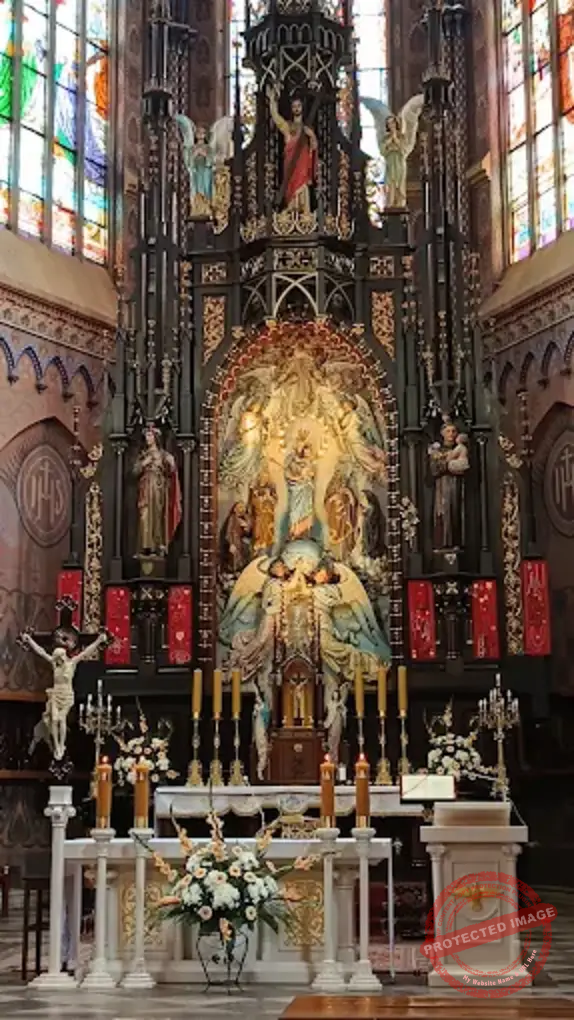
The miraculous statue of Our Lady of the Angels
Our Lady of the Angels has been venerated in Dbrowa Górnicza, the center of the current Sosnowiec diocese, since 1904. An image of Mary that was given to Father Grzegorz Augustynik by the faithful from Woszczowa, where he was the parish priest, served as the artist’s model for the statue of Our Lady and the Child. The cypress statue for the Dbrowa basilica’s main altar was created by Czstochowa’s Józef Baltazar Proszowski. Mary, surrounded by God the Father and the Holy Spirit , as well as saints Joseph, Joachim, Francis, Clare, and angels, is shown standing as Queen of the World, wearing a crown and holding a scepter. She is standing on a globe and using her right foot to trample on a serpent’s body. She holds Jesus, who is holding the royal orb on his lap and has his arms outstretched, on her left arm. The Godmother makes a slight face turn toward the Child. She is clad in a pink dress with stylized Anjou lilies and a blue cloak with gold stars that also covers her head. The cloak has precious stones trimmed around the hem. Gold crosses adorn the white dress worn by the infant Jesus. Golden rays and twelve stars encircle her heads. The entire scene’s composition alludes to the typical depiction of sacra conversatione, or holy conversation, in which the Blessed Mother is frequently shown surrounded by saints. It also clearly shows the glory of Mary Immaculate, who receives the grace of Assumption and Coronation while being carried by two angels and trampling the serpent, which represents Satan. Angelic hordes and the Holy Trinity bear witness to this. On August 2, 1957, Cardinal Stefan Wyszyski, Primate of Poland, proclaimed Our Lady of the Angels to be the Mother of Zagbie and the Patroness of Dbrowa Górnicza as a special tribute from the faithful, who consider her to be “an effective intercessor with God and the surest help in times of trouble.” The May 19, 1968, coronation of the figure famous for Pope Paul VI’s graces with crowns by Primate S was a sign of special reverence for the people of Zagbie Dbrowskie. Wyszynski and Krakow’s Metropolitan K. Wojtyła.
Further history
Father Grzegorz Augustynik made an effort to secure an indulgence for the Church of Our Lady of the Angels while he was in Rome in 1900. It was elevated to the status of basilica (probasilica) by a brief issued by Leo XIII on March 19, 1901. The basilica was given permission to celebrate indulgences a year later, on May 3, the feast of St. Alexander, the first church’s patron saint; on November 13, which is also the feast day of St. Stanislaus Kostka; and the Porziuncola indulgence on August 2, the feast of Our Lady of the Angels. In 1904, a crowned statue of Our Lady of the Angels, renowned for its graces (170 cm high), carved from cypress by Baltazar J. Proszowski, was placed in the main altar. The centerpiece of the main altar is this statue. The walls and vaults of the temple are adorned with an Art Deco painting that Micha Kowal and Jan Nyga “the Elder” created between 1927 and 1929.
Architecture of Basilica of Our Lady of the Angels, Dąbrowa Górnicza, Poland
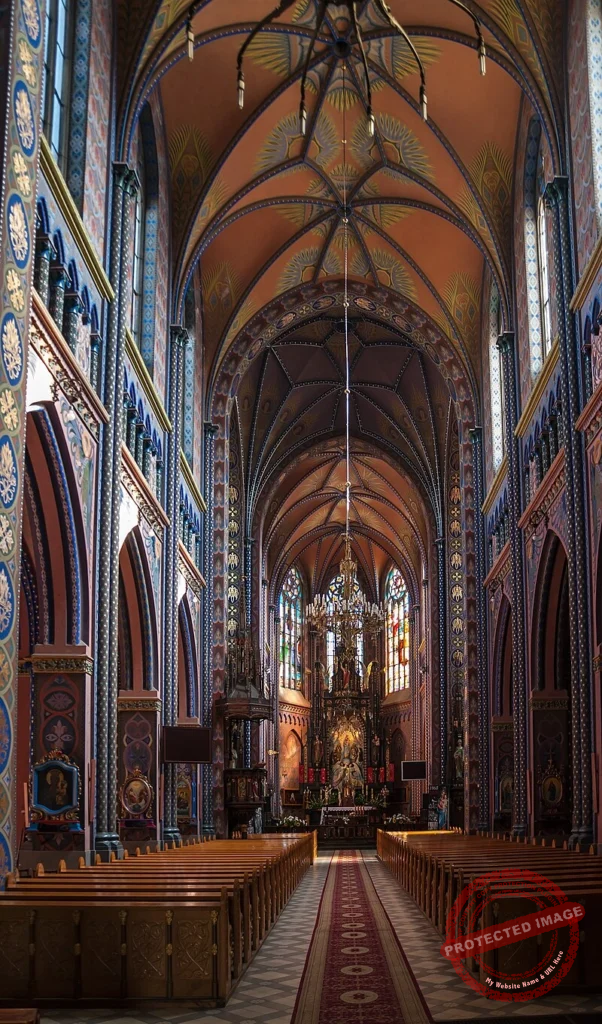
Architect : Józef Stefan Pomian-Pomianowski
Architectural style: Gothic Revival architecture
Interior
The inside of the Basilica of Our Lady of the Angels is full of neo-Gothic details that cover almost everything the altars, the pulpit, the confessionals all made in the same style, which gives the whole place a special atmosphere. The main altar is the most impressive, with lots of painted and sculpted decoration. Right in the middle, there’s a painting showing the Holy Trinity surrounded by saints like St. Joseph, St. Joachim, St. Francis, and St. Clare, and just in front of it stands a statue of Mary with the baby Jesus, which people believe is miraculous. On each side are statues of St. Rosalia and St. Anthony of Padua, and above, there are small figures of the archangels Michael, Gabriel, and Raphael. The first image of Our Lady of the Angels was placed in the church in 1897, based on the famous painting of Our Lady of Włoszczowa. The statue that stands there now was carved out of cypress wood in 1904 by Józef Baltazar Proszowski Mary is holding a scepter in one hand and Jesus in the other, who holds a royal orb on His knees, and the statue is 170 cm tall. In the transept there are more neo-Gothic altars one for St. Barbara with statues of St. Kinga and St. Hedwig, and another for the Sacred Heart of Jesus with a Crucifixion painting and figures of Mary and St. John the Evangelist. Around the chancel, there’s an altar for Our Lady of the Rosary with statues of Silesian patron saints Blessed Czesław and St. Jacek, and St. Anthony on top. Another altar is for St. Joseph, with statues of Polish saints St. Adalbert and St. Stanislaus, and a figure of Blessed Wincenty Kadłubek at the top. The Chapel of St. Alexander has wall paintings showing angels and saints and an altar with an image of Our Lady of Częstochowa. At the very end is the small Porziuncola Chapel, built in 1913, which is also the resting place of Father Grzegorz Augustynik, who played a huge role in building the basilica.
Renovation
St. Alexander’s Church was renovated in 1910 by Piotr Niziński from Kraków, likely according to Tetmajer’s design, with funds coming from donations from high-ranking officials of the Vienna Railway, in its original form thanks to preserved designs. The church was thoroughly renovated in 1952. The polychromes were restored by the painter Wacław Pużyński, based on the original surviving cartons. To commemorate receiving the indulgence of the Porziuncola, Father Grzegorz Augustynik built a chapel next to the basilica in 1913, where he was buried after his death in 1929. Inside is the first painting of Our Lady of the Angels from the high altar of St. Alexander’s Church.
The Basilica of Our Lady of the Angels
A minor basilica is a church that holds special privileges given by the Pope because of its important role in worship, community work, history, and art. The very first church to get this title was St. Nicholas in Tolentino back in 1783. The word “basilica” comes from Greek and means something like “royal hall,” which was a big, important building in ancient times. The Church of Our Lady of the Angels in Dąbrowa Górnicza was given the title of basilica on March 19, 1901, making it the first Marian sanctuary in Poland to receive this honor. Later on, in 1957, Primate Stefan Wyszyński, speaking for the Vatican, declared Our Lady of the Angels the patron saint of Dąbrowa Górnicza and the whole Zagłębie region, showing how much this church means to the people there.
Feast Day
Feast Day : 02 August
The main feast day of the Basilica of Our Lady of the Angels in Dąbrowa Górnicza, Poland is celebrated on August 2nd, the Feast of Our Lady of the Angels, also known as the Porziuncola. This day holds special importance for the basilica and its faithful, marking a time of deep devotion and local pilgrimage.
Church Mass Timing
Monday to Saturday : 7:00 AM , 7:30 AM , 6:00 PM
Sunday : 7:00 AM , 9:00 AM , 10:30 AM , 12:00 AM , 4:00 PM , 6:00 PM , 8:00 PM
Church Opening Time:
Monday to Saturday : 06:30 AM, 07:30 PM
Sunday : 06:30 PM, 09:00 PM
Contact Info
Address : Basilica of Our Lady of the Angels
Królowej Jadwigi 17, 41-300 Dąbrowa Górnicza, Poland
Phone : +48 32 262 27 16
Accommodations
Connectivities
Airway
Basilica of Our Lady of the Angels, Dąbrowa Górnicza, Poland, to Katowice International Airport, distance between 26 min ( 31.7 km )via S1.
Railway
Basilica of Our Lady of the Angels, Dąbrowa Górnicza, Poland, to Dąbrowa Górnicza Train Station, distance between 3 minutes ( 1.4 km )via Queen Jadwiga/DW910.

